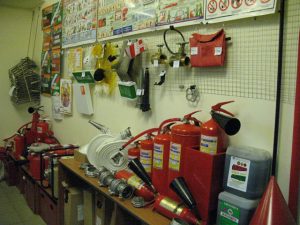Labor protection and fire safety at work
Labor protection and fire safety of industrial enterprises is an important set of measures to ensure the preservation of the health of industrial workers. Such rules are developed and approved by special commissions whose activities are aimed at preventing accidents in the workplace.
The Labor Code is a special collection of safety rules. The employee must learn them in order to know exactly all the requirements for his work and to minimize the chance of an accident, since most accidents occur precisely out of ignorance.
Objectives and goals
To provide all employees of the company with a safe work, to preserve their health and life, a number of measures must be taken:
- to form work that ensures the organization of fire safety;
- create conditions conducive to the assimilation by workers of all safety prescriptions;
- develop and encourage the competence of employees and managers;
- strict observance of the rules enshrined in the approved regulations;
- not to allow any deviations from the approved and proven practice of carrying out work operations, since any mistake can cause an accident or cause a fire;
- clearly separate the responsibilities of employees and superiors;
- observe fire safety regulations.
These goals must be fulfilled by all employees of the enterprises, without exception.
Complex of measures
It is especially important to correctly guarantee fire safety.
As a rule, they differ depending on the area of production, the size of the enterprise, technical equipment and the number of employees. However, the main among others are:
- development, as well as active implementation in accordance with the approved documents of the fire safety management system. The first and main step in organizing the proper fire safety of workers. The head of the enterprise and a group of selected persons develop rules, and then train employees on the basic requirements: on the use of industrial equipment, heating and ventilation systems, on the maintenance of office premises and rooms, on the storage of materials and equipment, on the proper maintenance of electrical networks and electrical appliances, on joint organized actions during a fire;
- supervision and control of the accident rate of equipment and premises at the enterprise. Inspection of equipment, electrical networks, workshops and offices is given to the responsible persons elected by the head of the enterprise, who monitor all this in the department entrusted to them. In the event of a fire hazard, all responsibility rests with the superior. The head of the enterprise is also obliged to draw up labor protection;
- provision and guarantee of protection against accidents when working with equipment, operating mechanisms and premises. This part of the complex includes the mandatory observance of all the rules of regulatory documents on the use of all mechanisms (non-mechanized and automatic), conveyors, on the correct use of lifts and similar possibly dangerous mechanisms, on the use of power grids and shields, on maintaining the premises;

- equipping the organization with fire extinguishing and fire prevention means, their regular replacement. In order to prevent large casualties and losses, in accordance with the law, each enterprise must have special fire sound warning systems that react to smoke, as well as gas fire extinguishers. It is advisable to have one or two shields on each floor with fire-fighting equipment (fire hose, ax and bucket);
- drawing up an annual plan and collecting funds to ensure safety from fires. One of the main conditions for successful fire safety at work is drawing up a safety plan for the next year. Based on the approved schedule, the administration prepares a financial budget, part of which will be spent on fire protection;
- training in fire safety rules for employees of the enterprise. Includes several briefings, different in level (introductory, initial, target). Reading lectures on safe behavior in case of fire. Carrying out classes, working out possible situations in case of fire;
- regular check of the condition of the power grid. Maintaining electrical safety is essential not only to protect workers from electric shock, but also to prevent short circuit fires. According to the statistics of the Ministry of Emergency Situations, more than half of all fires in industrial visits occur as a result of electrical safety violations. To create the necessary conditions for activity, it is necessary to carry out several important measures. Specialists should regularly measure voltage in installations, check grounding, in case of emergency cables and wires - replace them with new ones. It is recommended to periodically replace all electrical equipment with a newer one.
What documents are needed at the enterprise
So that there are no disagreements during the conduct of employees of the enterprise, there are special documents governing the rules of conduct in the event of a fire, standards for handling equipment, the duties of each employee.
Different industries accept and approve different lists of such papers.
Those that are required by the fire supervision service are mandatory for everyone:
- mandatory orders on the appointment of persons responsible for briefing, checking the means of warning and extinguishing the flame;
- evacuation plans from a burning building in prominent places on each floor;
- orders to consult employees on fire safety rules at the enterprise, as well as to test their knowledge;
- documents, tables or graphs of measurements of the resistance of electrical networks;
- availability of simulators, programs or manuals for training employees' skills;
- a journal that records the dates of training sessions and training alarms;
- certificates confirming the quality and shelf life of all fire extinguishing agents and fire prevention, fire fighting equipment;
- the conclusion of professional experts, confirming the knowledge of the employees of fire safety rules;
- the conclusion of the professional commission on the compliance with the fulfillment of fire requirements;
- acts and approved instructions of the fire regime.
A complete set of documents can be obtained from the employees of the fire services.
Instructions for drawing up an evacuation plan
And material assets in the event of a fire at the enterprise is mandatory to ensure labor protection. To draw up it, either an authorized person (for small buildings) or a special commission (for larger ones) meets.
The latter includes: the chairman of the fire-technical commission, his deputy, as well as the chief of the fire department of this company.
The first step is to draw up a building plan to calculate the expected movement of people in the event of an accident. Then a plan is made for the outer part of the enterprise to predict the movement of transport. A plan is drawn up for the movement of people to the exits.
In addition, the commission takes care of the preservation and evacuation of valuable items, expensive equipment and documents. Separate evacuation plans are drawn up for them.
Then, by the selected commission, responsible persons are appointed to monitor the implementation of safety rules. The duty schedule is introduced. The places for the ignition keys are determined.
After that, the places of storage of documents, hazardous flammable substances are approved. Fire exits are organized.

The plan must be approved by the chairman of the commission. The option is approved by the head of the enterprise. Then, in two parts (graphic and written) it is posted in the company itself. The second copy should be kept in documents.
In case of changes in the structure or layout of the premises, the person in charge must promptly make the necessary amendments to the scheme and documents.
The attached instructions to the plan should contain: the duties of the designated persons and the procedure for their actions to evacuate people, equipment and other valuable things, how the beginning of the evacuation will be announced, instructions for the evacuation of vehicles, how employees should extinguish the fire, the location of the means to eliminate the flame.






